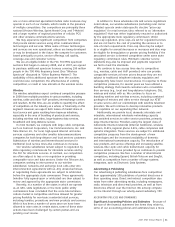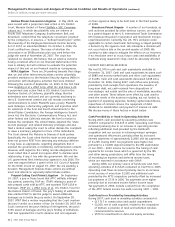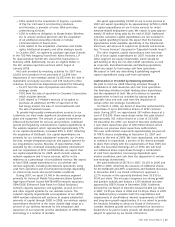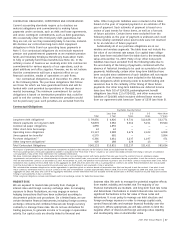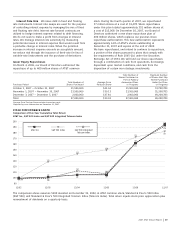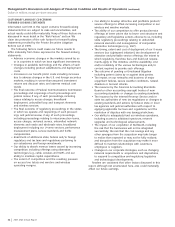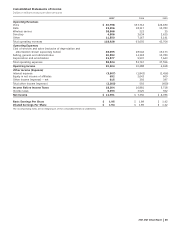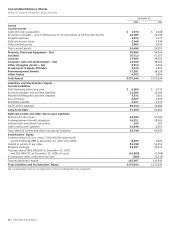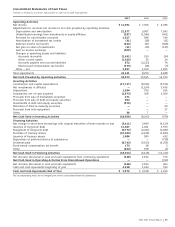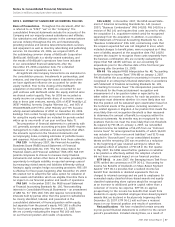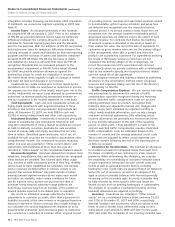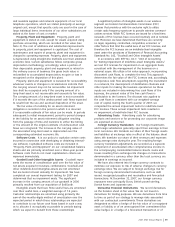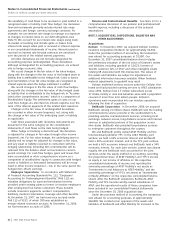AT&T Wireless 2007 Annual Report Download - page 52
Download and view the complete annual report
Please find page 52 of the 2007 AT&T Wireless annual report below. You can navigate through the pages in the report by either clicking on the pages listed below, or by using the keyword search tool below to find specific information within the annual report.
50
| 2007 AT&T Annual Report
Management’s Discussion and Analysis of Financial Condition and Results of Operations (continued)
Dollars in millions except per share amounts
CERTIFICATION BY THE CHIEF EXECUTIVE OFFICER
As required under the rules of the New York Stock Exchange
(NYSE), our chief executive officer has timely submitted to
the NYSE his annual certification that he is not aware of any
violation by the company of NYSE corporate governance
standards. Also as required under the rules of the NYSE,
readers are advised that the certifications required under
Section 302 of the Sarbanes-Oxley Act of 2002 are not
included in this report but instead are included as exhibits
to our Annual Report on Form 10-K for 2007.
RISK FACTORS
In addition to the other information set forth in this document,
including the matters contained under the caption “Cautionary
Language Concerning Forward-Looking Statements,” you
should carefully read the matters described below. We believe
that each of these matters could materially affect our business.
We recognize that most of these factors are beyond our
ability to control and therefore to predict an outcome.
Accordingly, we have organized them by first addressing
general factors, then industry factors and, finally, items
specifically applicable to us.
Adverse changes in the U.S. economy could materially
hamper our customers’ abilities to purchase our products
and services.
We provide services and products to consumers and large
and small businesses in the United States and to larger
businesses throughout the world. While our wireless customers
are located throughout the United States, our wireline
consumer and small business customers are located in the
22 states in which we provide local exchange services.
Adverse changes in the U.S. economy are likely to adversely
affect these customers’ ability to pay for existing services
and to decrease their interest in purchasing new services.
Should this customer pullback occur, we likely would
experience both a decrease in revenues and an increase in
certain expenses, including expenses relating to bad debt.
We are also likely to experience pressure on pricing and
margins as we continue to compete for customers who
would have less discretionary income. While our large-
business customers are less likely to be affected by adverse
changes in any particular economy, a lengthy U.S. or a global
recession would tend to affect them in a similar manner.
Adverse changes in medical costs and the U.S. securities
markets and interest rates could materially increase our
benefit plan costs.
Our pension and postretirement costs are subject to
increases, primarily due to continuing increases in medical
and prescription drug costs and can be affected by lower
returns in prior years on funds held by our pension and other
benefit plans, which are reflected in our financial statements
over several years. Investment returns on these funds depend
largely on trends in the U.S. securities markets and the U.S.
economy. In calculating the annual costs included on our
financial statements of providing benefits under our plans, we
have made certain assumptions regarding future investment
returns, medical costs and interest rates. If actual investment
returns, medical costs and interest rates are worse than those
previously assumed, our annual costs will increase.
The FASB required companies to recognize the funded
status of defined benefit pension and postretirement plans as
an asset or liability in our statement of financial position and
to recognize changes in that funded status in the year in
which the changes occur through comprehensive income.
Therefore, an increase in our costs will have a negative effect
on our balance sheet.
Changes in available technology could increase
competition and our capital costs.
The telecommunications industry has experienced rapid
changes in the last several years. The development of
wireless, cable and IP technologies has significantly increased
the commercial viability of alternatives to traditional wireline
telephone service and enhanced the capabilities of wireless
networks. In order to remain competitive, we have begun to
deploy a more sophisticated wireline network and continue
to deploy a more sophisticated wireless network, as well as
research other new technologies. If the new technologies
we have adopted or on which we have focused our research
efforts fail to be cost-effective and accepted by customers,
our ability to remain competitive could be materially
adversely affected.
Changes to federal, state and foreign government
regulations and decisions in regulatory proceedings
could materially adversely affect us.
Our wireline subsidiaries are subject to significant federal
and state regulation while many of our competitors are not.
In addition, our subsidiaries and affiliates operating outside
the U.S. are also subject to the jurisdiction of national and
supranational regulatory authorities in the market where
service is provided. Our wireless subsidiaries are regulated
to varying degrees by the FCC and some state and local
agencies. The adoption of new regulations or changes to
existing regulations could significantly increase our costs,
which either would reduce our operating margins or
potentially increase customer turnover should we attempt
to increase prices to cover our increased costs. In addition,
the development of new technologies, such as IP-based
services, has created or potentially could create conflicting
regulation between the FCC and various state and local
authorities, which may involve lengthy litigation to resolve
and may result in outcomes unfavorable to us.
Increasing competition in our wireline markets could
adversely affect wireline operating margins.
We expect competition in the telecommunications industry
to continue to intensify. We expect this competition will
continue to put pressure on pricing, margins and customer
retention. A number of our competitors that rely on
alternative technologies (e.g., wireless, cable and VoIP) are
typically subject to less (or no) regulation than our wireline
and ATTC subsidiaries and therefore are able to operate with
lower costs. These competitors also have cost advantages
compared to us, due in part to a nonunionized workforce,
lower employee benefits and fewer retirees (as most of the
competitors are relatively new companies). We believe
such advantages can be offset by continuing to increase
the efficiency of our operating systems and by improving
employee training and productivity; however, there can be
no guarantee that our efforts in these areas will be successful.



